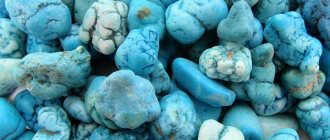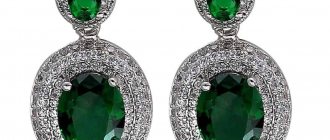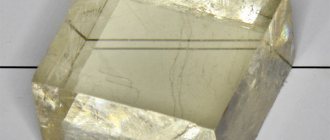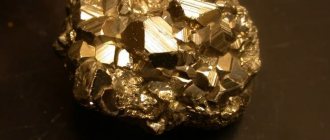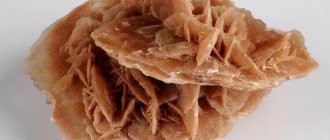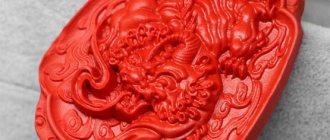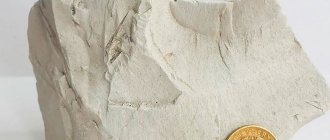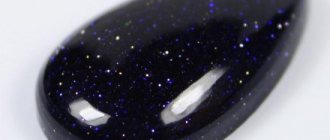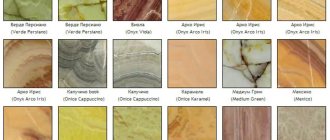/ List of stones / Properties of the mineral magnesite
0
2167
Article rating
The mineral magnesite belongs to the group of carbonates. It got its name from the Greek region of Magnesia, where it was discovered. There is a synonym - magnesium spar.
Properties of the mineral magnesite
History and description of the stone
This mineral was first discovered by the ancient Greeks in Magnesia, a coastal part of the historical region of Thessaly, on the coast of the Aegean Sea. Already in ancient times, different types of magnesite were used to produce refractory bricks necessary for the smelting of metals. The mineral was also used in jewelry.
There are 2 types of magnesite stone depending on its origin:
- crystalline, shiny, transparent;
- amorphous, similar in appearance to marble, but less durable (comparable to porcelain), matte.
The first was formed as a result of the interaction of igneous rocks with hot fresh and salt waters in the Paleozoic and Precambrian eras. The second - later as a result of chemical weathering.
The main color is white (due to magnesium in the formula). Impurities of iron, calcium, manganese, nickel, and cobalt give the mineral yellow, pink, cream, brown, and greenish shades.
Areas of application
Magnesite rock is suitable for the production of building materials, including:
- refractory brick that can withstand heating up to 300°, which acts as a facing material for furnaces, protecting them from thermal and chemical influences.
- insulating mass for building boards with magnesite used for external and internal decoration,
- artificial marble slabs and decorative stone obtained from mineral caustic powder by pressing in combination with adhesive compositions,
- plasters with high resistance and increased technical service life,
- binding material - magnesite cement, which is used in the manufacture of grinding wheels,
In the chemical industry, magnesite ore and magnesium salts are produced from magnesite. Due to its fire-resistant properties, it serves as the basis for fire-resistant paint and varnish coatings and is a component in the production of electrical insulators.
In metallurgy it is necessary in the production of sulfuric acid. The refractory stone magnesite is used in the production of ceramic and glass products. In pharmaceuticals it acts as an analogue of talc. In demand in the rubber and paper industries.
Place of Birth
The largest deposits of magnesite are located in Russia. The world's largest deposit for industrial needs is Savinskoye in the Irkutsk region. Industrial development is carried out in the Volga region, Krasnoyarsk region, the Far East and the Urals. In the Satka deposits of the Chelyabinsk region there are not only industrial designs, but also crystalline ones used for jewelry purposes.
In addition to our country, magnesite is mined in:
- Greece;
- Poland,
- North Korea,
- USA,
- India,
- Australia,
- China,
- Austria,
- Czech Republic,
- Canada,
- Brazil.
Origin story
The ancient origin of the stone has been historically proven. The mineral magnesite was first discovered in Ancient Greece in a large mine located on the Magnesia (Magnesia) peninsula. The stone was named after this province (Magnesite).
The mineral interested workers due to its fire-resistant properties. It retained its shape and structure after firing at high temperatures.
It began to be used in the industrial sector. And jewelers were interested in the beautiful shine of the crystal.
In Russia, geologists discovered magnesite deposits at the Satka mine in 1894. Employees of the local plant also paid attention to the fire-resistant properties of the mineral and began to study the nucleation.
The stone began to be mined 5 years after its discovery. It was only in the mid-20th century that the mine began to be developed regularly.
Soon, Russian researchers discovered large deposits in the city of Berezovsky (Sverdlovsk region). In 1968, it began to be actively mined.
Magic properties
Most stones used in the form of jewelry are endowed with magical qualities by people. These properties are also attributed to magnesite. It is believed that wearing an amulet made from this stone:
- It will boost your immunity and protect you from epidemics.
- Calms your nerves.
- Improves vision.
- Will teach the owner to communicate with animals, train them, and understand their language.
- Makes children calm and obedient.
- Will help you find a life partner.
- Improves relationships with relatives.
- Builds relationships in the work team (put a pyramid, prism or cube on the desktop).
- Will protect you from accidents and natural disasters on the way.
- Will open the abilities of clairvoyance and clairvoyance.
- Will reveal the talents of creative people, especially artists.
Properties and photos of magnesite
Magnesite crystal. © Rob Lavinsky
The luster of granular varieties is glassy, while dense varieties are matte. Hardness 4-4.5. Specific gravity 2.9-3.1 g/cm3. The color of granular varieties is grayish-white, yellowish, while that of dense varieties is white, cream, yellowish, brown, gray. The line is white. Crystalline magnesite has perfect cleavage in three directions along the faces of the rhombohedron. The fracture in granular varieties is grainy, while in dense varieties it is uneven. Marble-like masses composed of elongated grains (different from marble and dolomite), and dense porcelain-like formations, rarely crystals, in the form of rhombohedrons. The crystals are usually ingrown. Trigonal syngony. The mineral forms aggregates of irregular grains, often so small that the mineral has a porcelain-like appearance.
Features . Magnesite is characterized by a non-metallic luster, medium hardness and boiling of magnesite powder under the action of heated hydrochloric acid. This is how magnesite differs from similar minerals - calcite, dolomite. It differs from siderite in color. Marble has isometric grains, while magnesite has elongated grains.
Chemical properties . The powder boils when exposed to heated hydrochloric acid.
Medicinal properties
Magnesium carbonate is included in a number of medications that help with exacerbations of diseases of the gastrointestinal tract: gastritis, stomach and duodenal ulcers, constipation.
Pure magnesium is obtained from the mineral, which is used to create vitamins containing this trace element.
Natural magnesite stones are used for massage for arthrosis, arthritis, radiculitis, and other diseases of the musculoskeletal system.
Athletes rub powdered magnesia (a mixture of magnesium carbonate and bicarbonate) on equipment in gymnastics and weightlifting to avoid injuries and falls.
Where is it used?
The processed stone, in the form of caustic magnesia, has found application in practical industries:
- metallurgy;
- pulp production;
- production of viscose, rubber, plastics, glass;
- creation of thermal insulation materials, refractories, ceramics;
- as a component of construction cement;
- in agriculture it is used as fertilizer.
The best samples (of which there are not many) are taken by stone cutters and jewelry makers. Large companies are not interested in it because it is cheap; hand-made masters create entire sets.
Magnesite colors
For jewelry, talismans and amulets, matte and transparent crystals of white, yellow, pink, green colors with a glass sheen are used.
Yellow stones are mined in deposits in Australia, pink ones with opal particles are mined in France, large stones of a beautiful brown hue are mined in Brazil.
What does the mineral look like?
Magnesite is a crystalline or granular formation with a matte or glassy sheen.
The following varieties are distinguished:
- Mesaite spar. Stones with iron content 50-69%
- Brainnerite. Stones with an iron content of 70-90%.
- Glandular. Specimens of brown shades.
- Helmagnesite. Amorphous formations.
- Nickel.
These are stones with different composition, formula, and degree of transparency. Their palette is white, gray, brownish, pinkish, yellowish.
Polished magnesite looks like marble.
Compatibility with zodiac signs
In astrology, it is believed that the magnesite stone protects the zodiac sign of Gemini. It protects against spontaneous decisions and losses, helps to tame excess excitement, and attracts good luck in games and business.
It helps Virgos and Capricorns to hear the voice of the heart, activate the work of the brain, and enable luck in career and business.
Important information
This mineral is contraindicated for Aries and Aquarius: it will lead them to depression with loss of interest in surrounding events or a nervous breakdown.
For other signs this stone is neutral. They can use it based on its magical properties.
Jewelry with mineral
Sonia Choquette wrote: “You must find a stone that reflects your spiritual burden.” When deciding that magnesite will serve as an amulet, it is important to correctly understand which mineral you will have to come into contact with. A stone of such amazing power is capable of fulfilling the tasks of a talisman; it carries an enormously powerful charge that you will have to learn to control.
Also read: Simbirtsit - a miracle mineral from the banks of the Volga
They charge the mineral, take care of it and always keep it with them, and it pays for it in kind. Not all gemstones are compatible with jewelry; the set should be selected carefully. It is important to consider the compatibility of the mineral with the magical properties of other gems. At first, until you become related to your amulet, it is better not to pair jewelry with a stone of a different type with it.
The use of a gem should be beneficial, so jewelry is selected that will complement each other and help solve specific problems. It is known that magnesite protects human energy and prevents all sorts of troubles in life. It is advisable to use an amulet with a stone as often as possible, and try not to part with it.
Especially when traveling, when performing important tasks that require large energy expenditures. The price for jewelry with magnesite is affordable; anyone can buy it. For magical protection, you can buy a pebble even without a frame:
- tumbling stone from deposits in Zimbabwe, 1.5–2.5 cm in size costs $2.31;
- price for tumbling magnesite from the same deposit, size 2.5–3.5 cm, $3.2;
- a decorative element made of magnesite in the shape of an egg, 6.2–4.5 cm, is valued at $77.8;
- the price of an egg made of magnesite mined in Kazakhstan, size 8–5.8 cm, is $106.5;
- original bracelets made of silver and magnesite cost $25;
- the price for a ring with a stone, beads or rosary made of painted magnesite is $15 per piece.
Magnesite ornamental stone, in the form of a crystal, is used in jewelry. Bright yellow precious crystals are mined in Australia and Brazil.
Talismans and amulets
Magnesite can act as a talisman or amulet, protecting its owner and giving him strength to overcome dangers. The talisman is recommended to be carried with them at all times by people whose lives involve traveling - travelers, drivers and sailors. The stone also protects its owner from lurking dangers in the form of natural disasters and violent acts.
Amulets made of magnesite are placed around the neck of a child so that he finds peace and becomes obedient.
Use in folk medicine
Ancient healers used magnesite stone as a talisman against chronic diseases of internal organs. They believed that it prevents the development of pathologies and eliminates them in the early stages.
Allegedly, the stone increases the body’s immune strength and calms the nervous system. To do this, it is enough to sort the beads every day for 5-10 minutes. Nervous tension will subside, and a feeling of detachment and lightness will come.
In ancient China, white magnesite was used in eye treatment. It relieved redness and burning and improved vision. The stone is heated in your hands and placed on closed eyelids for 20 minutes.
The mineral helps eliminate discomfort. It is applied to the affected area for half an hour. It relieves pain from gout and arthritis.
Healing properties remove toxins and normalize the functioning of the sebaceous glands. Healers advise wearing magnesite beads or earrings for skin diseases.
